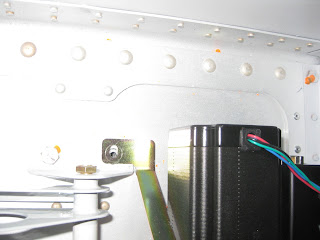Aileron actuation is complete. The rigging took me 11 hours. Most of that was consumed in using the wrenches in the severely restricted space within the wings.
First, one of the threads on my pushrod threaded rod end was damaged. Don't know if it came like that from the kit or if the weld shop did that (probably the latter, as it looks like drop damage). Fearing $100 to fix (new rod and welding labor), I learned I could use a rethreading die to solve my woes. This is part of the "education" mandate in experimental aircraft construction. I.e., I did not know one could fix damaged threads. Below is the 1/4" 28 TPI die itself and in action. I used a little oil to help it cut, along with a progression of two twists forward and one or so back to remove the debris.
Left side is damaged thread, right side is fixed. The thread was bad enough to strip the AN316-4R jam nut. I had to replace it.
The plans call for a 1 1/64" spacer to be used to clock the torque tube subassemblies.
That's some mighty fine resolution in measurement. I whipped out my compound miter saw to cut a piece of wood down to about 1 1/8" then worked it down with a long, flat file using my caliper to measure. Once that was done, it's just a matter of engaging the torque tube collar to the right length (I went for 17 3/4") then completing the requisite match drilling. Left and right shown on their respective sides below.
I foolishly torqued in the final bolts before approaching the wing roots. Realizing I skipped a step, I eviscerated some time removing a few bolts. Curious why my collars are primed grey and not the usual white as seen elsewhere in my build? Read here.
Installation of the subassemblies must be completed with little to no pre-loading on the flanged bearings. On each side, I had to use three NAS1149F0432 washers (two on top, one on bottom) to properly seat the subassemblies. Left and right shown on their respective sides below, top to bottom. The washers are clearly visible.
The plans call for a NAS1149F0363P
washer to be inside the torque tube clevis arm along with the pushrod
bearing. This is not easy as the arm must be spread to fit the bearing
and washer. I wonder why Van's called for this. Left on left, right on right.
Here's the bellcrank jig to hold the assembly in the neutral position. This is to properly size (by engagement of the rod end bearings) the torque tube to bellcrank pushrod.
Aileron pushrod installed onto aileron.
The alignment template holds the aileron in the neutral position. Notice how the aileron is actually deflected slightly upwards. This is apparently by design.
Everyone's torqued down onto the left bellcrank.
The torque tube gets very close to the main spar web in the full up position. That might require sanding out later (Update 15-May-18: It didn't). The hole that's shaped in the kit seems to be too large inboard and too small outboard. It almost as if the hole should be translated outboard in the master plans.
Wing tips next. I marvel at the folks who bang out wing kits in 300 hours. I'm on track for 600+ (Update 15-May-18: It took 611 total)! On 21-Jul-13 I guessed 450 hours when the tank baffles were ready for countersking. On 5-Oct-13 I guessed 700 hours when the flap skins were being bucked.























































